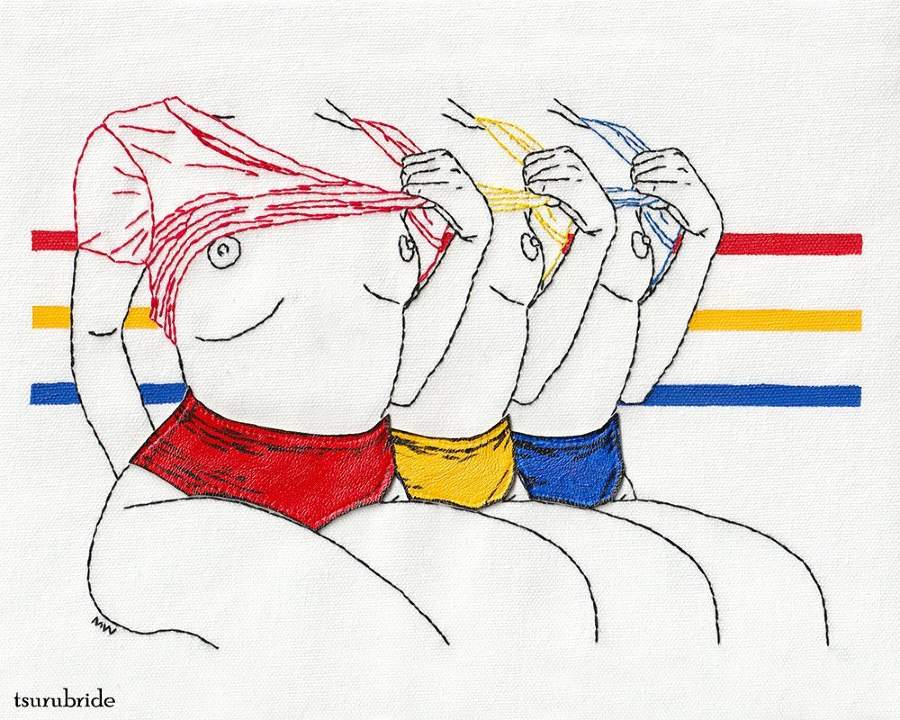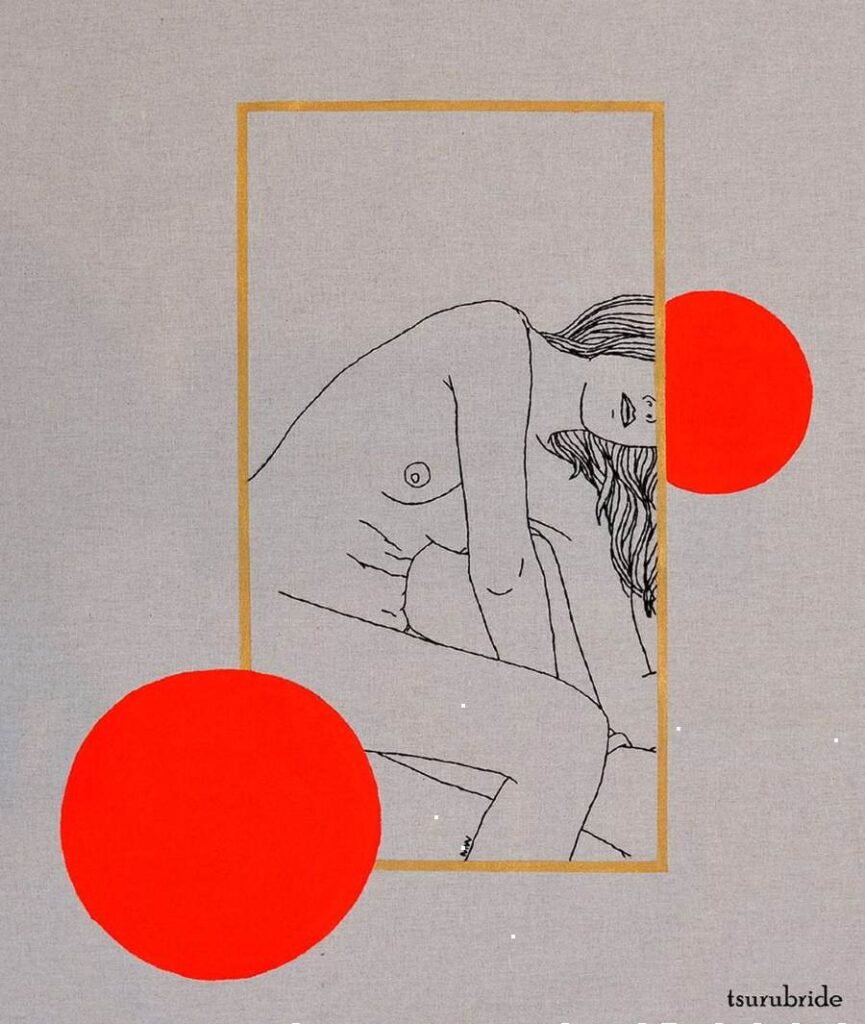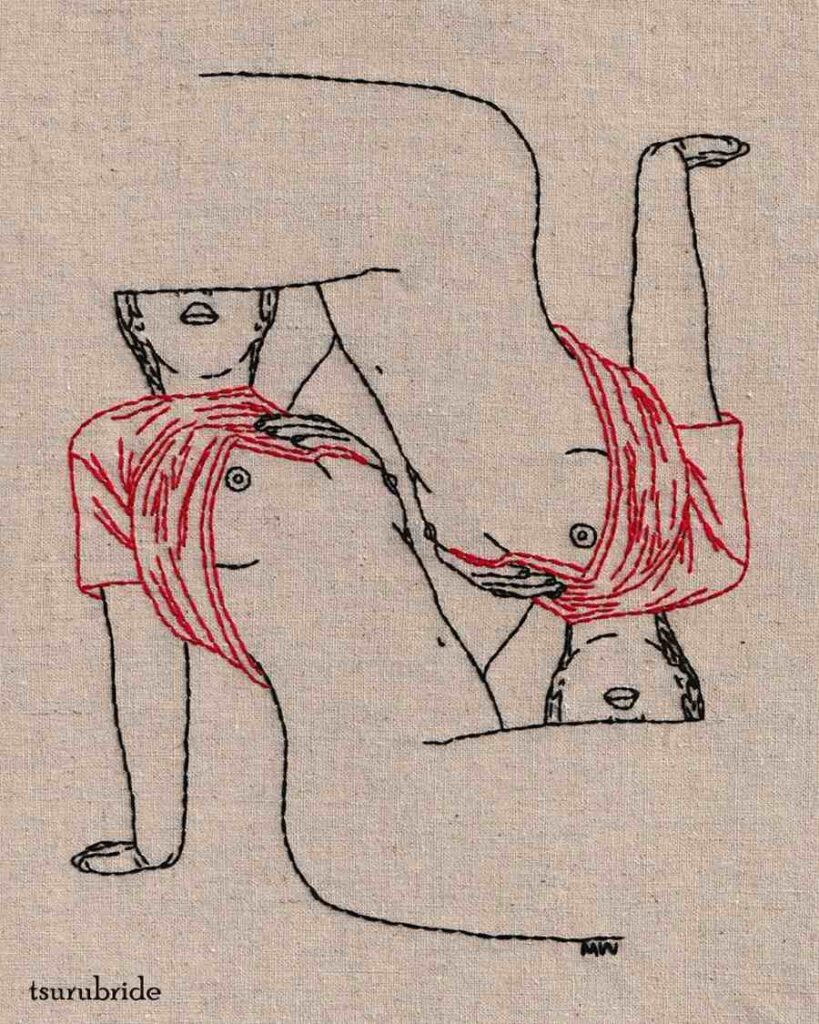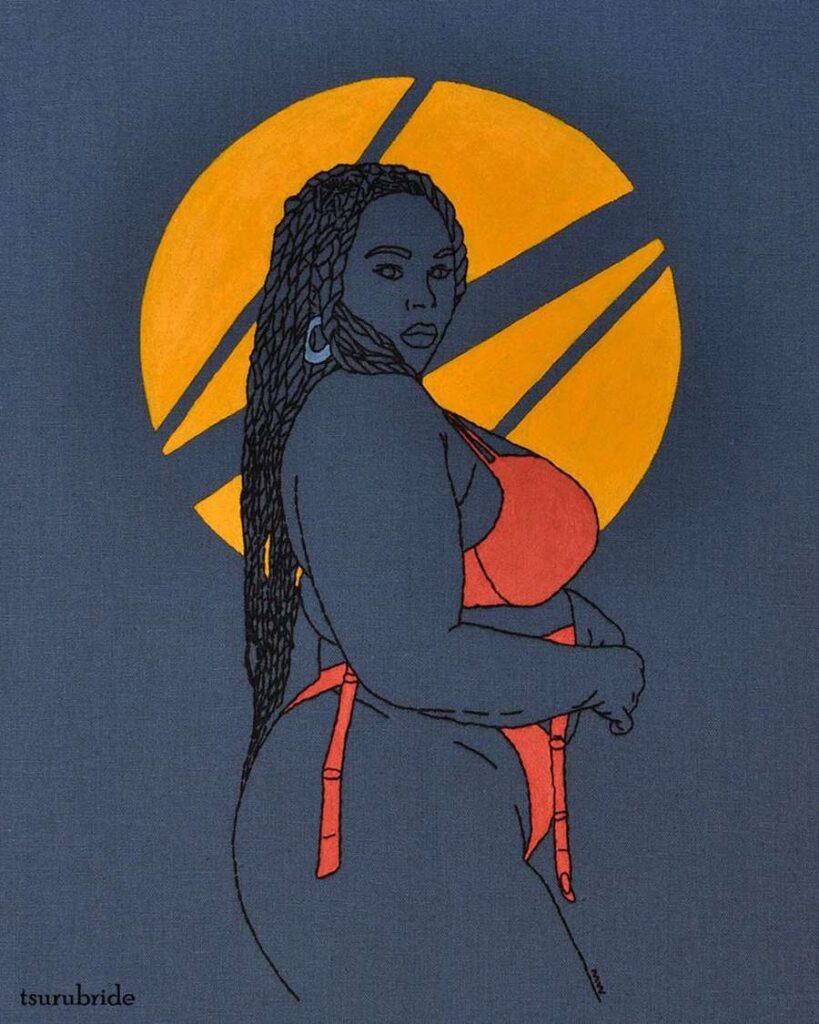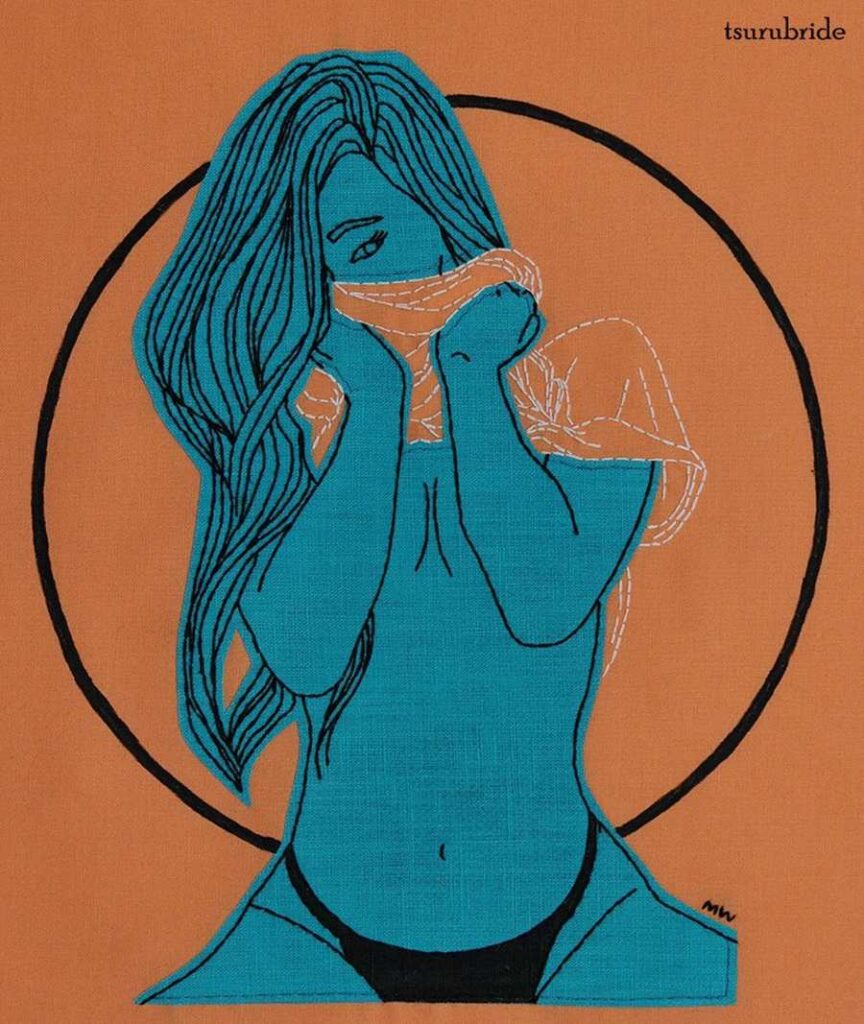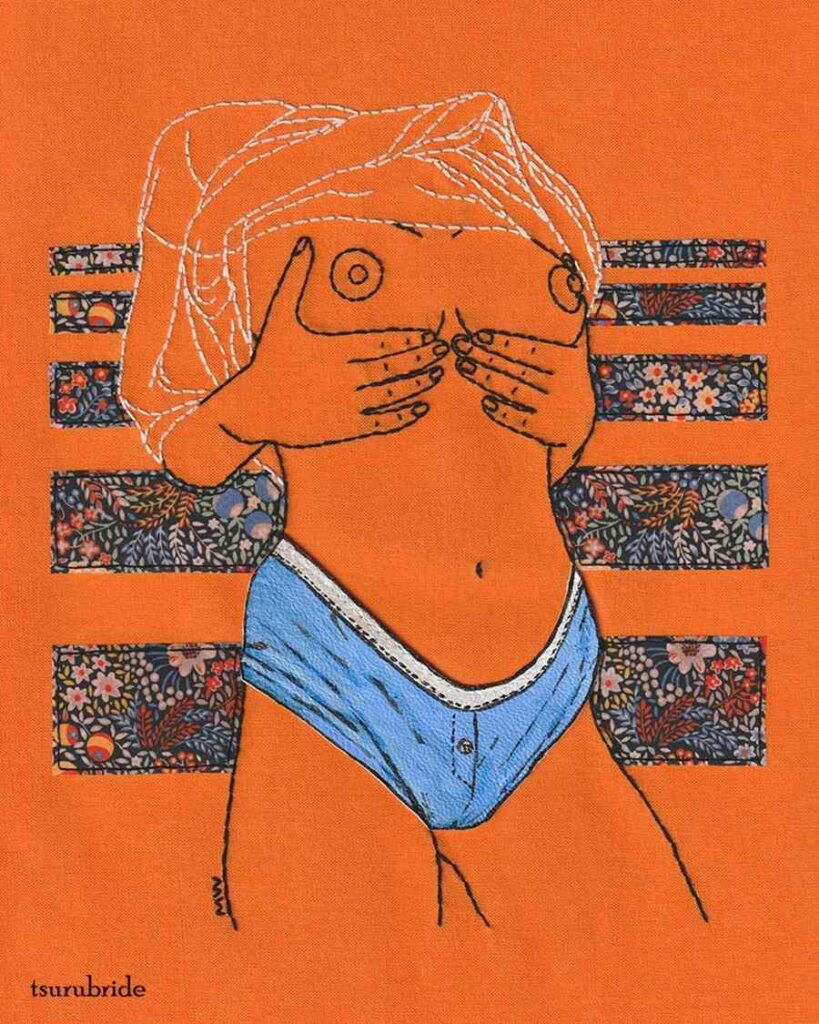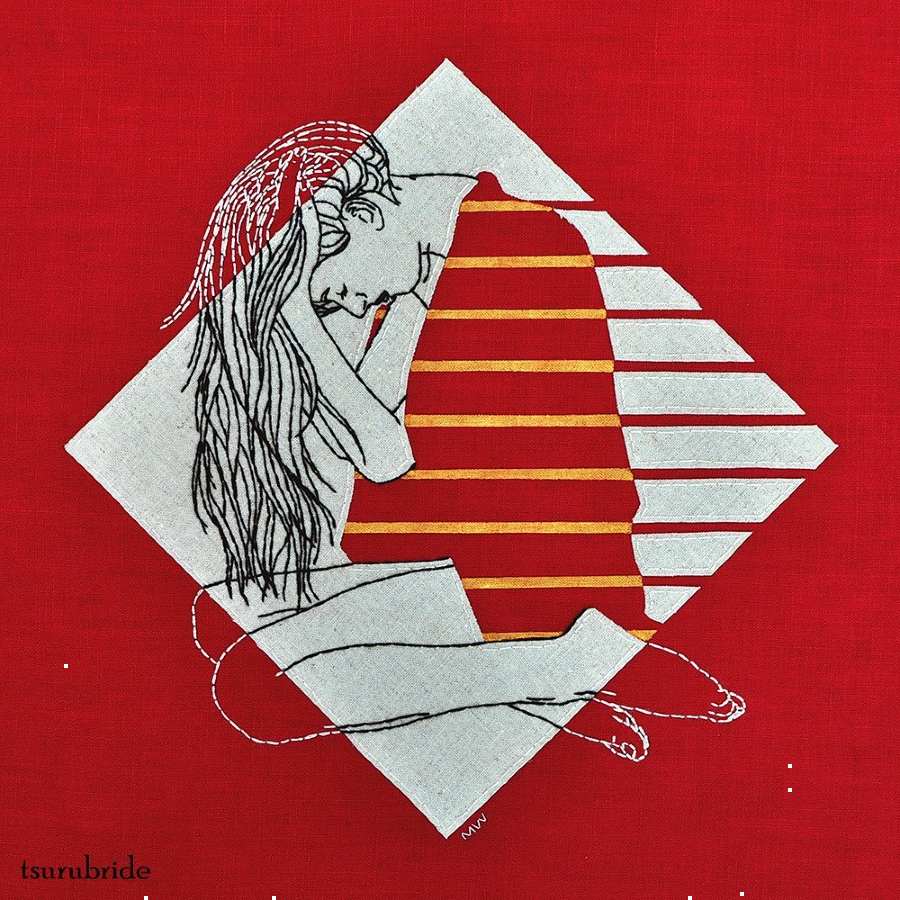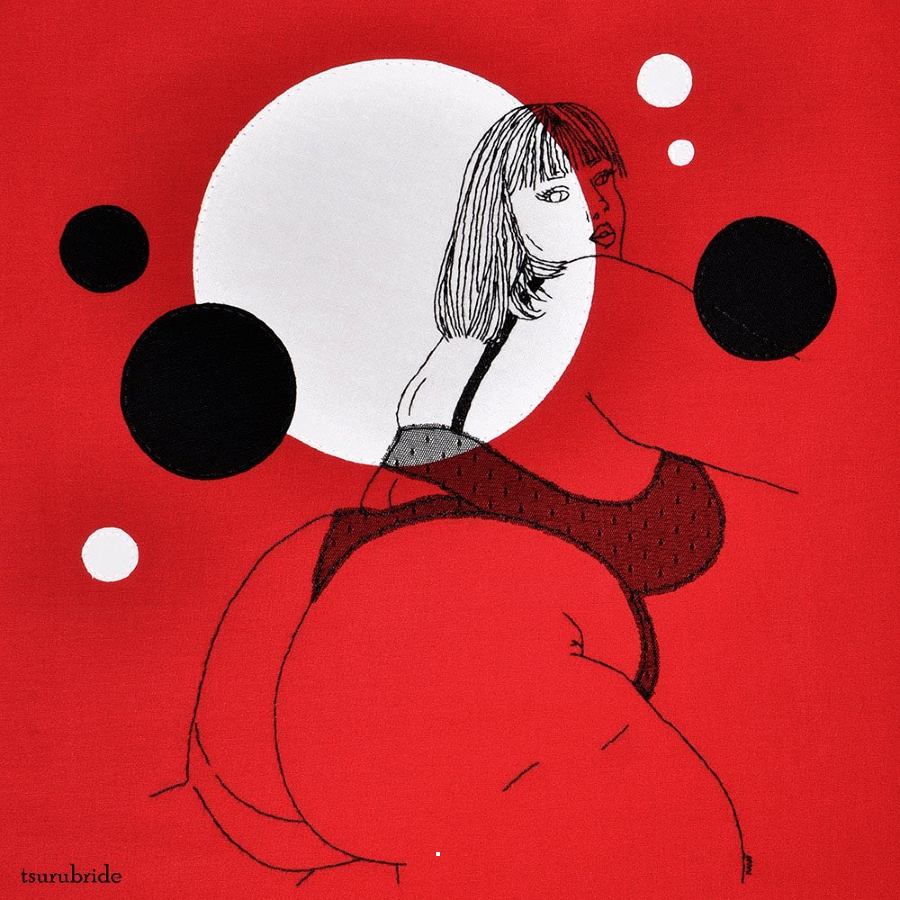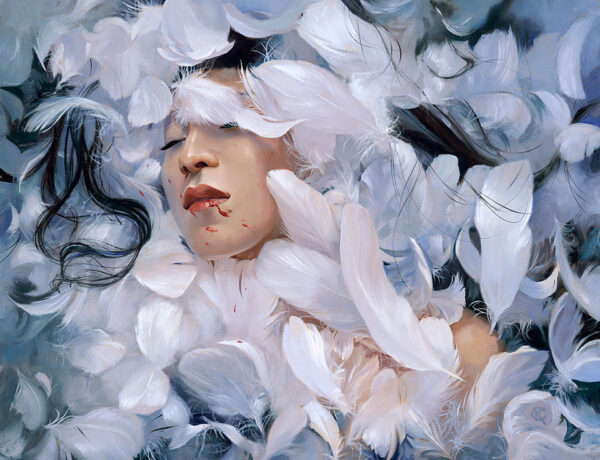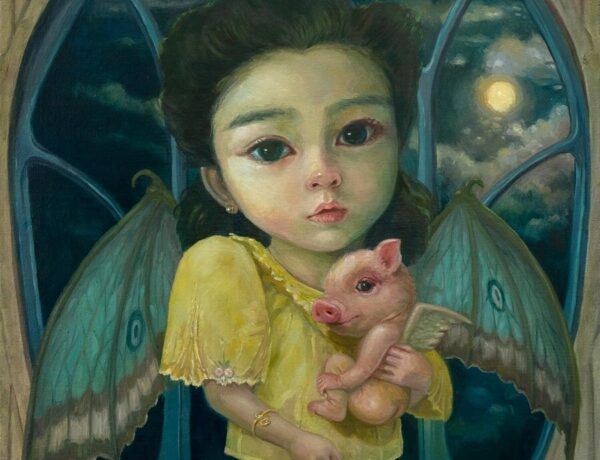Allow the stitching to slowly strip away your assumptions and expectation of the human form. Portraits teeming with desire; the act of undressing itself becomes a ritual, a sacred invitation into the world of careful, meticulous exposure. The ingenuity of every stitch, of the mindful intersection of line, angle, and color, is the spectacular work, embroidery, and imagination of artist Meghan Willis, aka tsurubride.
A gentle sensuality provokes the viewer to act as the ultimate voyeur, gazing at the subject in their most intimate space. Meghan captures yet subverts the sensitive dynamic between spectator vs. muse, reverting the power to the muse in their direct, unfaltering eye contact with the onlooker. Meghan Willis leaves us wanting (so much) more with her provoking textiles, emboldened by delicate embroidery, sultry textures, and striking use of color play.
Through the eye of the needle I am to explore the art of undressing, movement, and sexuality; to tempt the viewer to follow the delicate stitching that caresses the bodies revealed through thread.
Meghan, thank you for taking the time to share your artistic story with Beautiful Bizarre. Firstly, tell me about yourself.
I was born, and grew up, in Toronto, Canada. My mother first taught me to sew when I was about 6, desperate to learn how to make clothes for my Barbie doll, first by hand, then by machine. This desire to create continued to manifest in fashion and I ended up going to University and studying fashion design. My day job is still fashion-based, and it was through it that I was able to first move to the US (Columbus, OH, followed by New York City) and then Hong Kong. In my spare time, I kept consistently creating: clothes for myself or various projects, sketching, or other creative pursuits.
In 2011, I began exploring using textiles as an art medium, outside of fashion. My partner’s interest at the time was in nude photography and my fashion background (nude studies learning the human form, and sketching fashion on bodies), meant that embroidering the female form seemed a natural subject matter.
Do you have an artist statement you’d like to share?
Through the eye of the needle I am to explore the art of undressing, movement, and sexuality; to tempt the viewer to follow the delicate stitching that caresses the bodies revealed through thread. My work is soft textiles and romantic florals but stitched together with a sharp needle: plunging, pushing, and pulled together, stitch by stitch binding the piece together.
There’s a reason that the human figure is a persistent muse in art. Our form is malleable as a means to express different factions of ourselves, as well as portray how we see the world. Sometimes these figures fight or blend into nature, space, or time. For me, this is through layering different mediums, as well as forcing interactions with lines, angles, or shapes. Something sharp intersecting with ourselves, interrupting our path.
My goal is to celebrate diverse gender identities and expressions through the traditionally “female craft” of embroidery, demonstrating no gender or art is limited to a binary system.
Let’s start from the beginning. When did you realize you wanted to be an artist? Was there anything about your childhood in particular that made you pursue creative endeavors?
I grew up in a very creative household. My mom, to this day, will claim not to be creative, but when we were young she made clothes for us, our Halloween costumes were always handmade and super creative, and she definitely played with interior design at home. Both my grandmothers were into sewing and definitely encouraged me in that area. And my brother was also very artistic.
While we played a lot outdoors, I joke that we were indoor kids since we were definitely happiest drawing, copying, or creating our own comic or cartoon characters, building Lego, and storytelling with Barbie dolls. I learned to sew early and kept going with it. I was always somewhat more practical with it, creating clothes to wear out, and I never wanted to be the next big designer, but rather just create. Even now, I create for the sake of creating, getting ideas out of my head, and moving on to the next one.
What medium do you prefer to use and how did you develop your style?
I’ve been doing mixed media textile work with a focus on hand embroidery, since 2011. It started with a small show in Columbus, OH, where I had carte blanche to create some works. I had just purchased Tomoko Nakamichi’s “Pattern Magic” books and decided to play around with some of the techniques, as well as quilting and hand embroidery to tell the story of Marguerite de La Rocque: a 16th century Frenchwoman marooned on a deserted island off the coast of Newfoundland, Canada. My favorite aspect was the hand embroidery piece of it and I wanted to see what else I could create with it.
With a background in figure work, and having lots of photo references, creating work with the human figure seemed a natural fit. I happened to have a lot of leather lying around since I had been making and selling handbags in my spare time, so adding that layer in, also seemed a natural fit. My original textile work came about quite organically. I then kept building off that and built on my skills as well. A number of my first pieces never included faces, and the scale was really small, so I pushed myself to create more detailed work and slightly larger pieces. Between mixing textiles, I also adding in acrylics on the leather, which was an aesthetic choice for sure, but also, at the time, I didn’t really want to mess around with fill stitches. And even know, I’ll play with it in areas, but it’s still not my default.
I tried to challenge myself by not getting stuck on one medium. Originally, the work felt like it HAD to have leather, otherwise, was it even mine? But eventually, it felt like my voice came through regardless, and I was able to add in other textiles, embroidery, or beading, or colors, and my voice didn’t get lost.
Your work often depicts the female form with intersecting shapes, lines, and angles. What is your process from initial concept to final product?
While my work started with the female form, I want to caution my audience not to make gender assumptions. My work over the last couple of years, especially, includes a number of nonbinary or gender-nonconforming people.
I either create reference photos or source reference photos online. Some sit in my metaphorical to-stitch pile for a while, until the right idea comes along. I play with concepts on an iPad, sketching out ideas, doing variations on colors or concepts until something “feels” right.
Once I’m ready, I’ll trace out the image onto fabric using a fine pen. If there is fabric applique, though get a layer of double-sided interlining to secure to the base fabric before stitching. Then I place the fabric in a frame or hoop and get stitching! Depending on the piece, sometimes I’ll move the frame around as I’m stitching. I typically use DMC 6-ply thread and separate it into 2-plies. Most of my work is done in a backstitch – a really simple stitch.
If there’s paint for the straight lines, I use tape to map out where they’ll go and then applique 2 coats of acrylic paint. Other shapes I draw out ahead of time, then paint. Once I’m done, I keep everything out of the hoop/frame, so it’s flat/less bulky since space is at a premium here in Hong Kong. Once I have a show, or I sell a piece, I’ll stretch it over a wood frame.
Who are the subjects present in your work and what do you want the viewer to experience when looking at them?
The subjects in my work are everyone: your friend, your neighbor. It’s people along the gender spectrum. I’ve been trying to expand the diversity in my subjects: race, gender, and size. I’m not perfect at it, by any stretch, but I do want to portray variety. I want viewers to see themselves, and I want to challenge those who are stuck in binary thinking to be open-minded in experiencing my work.
My embroidery work is based on self-portraits, and I love sharing someone’s best version of themself.
What does embroidery mean to you? Does its history as a female-dominated practice influence the exploration of femininity found in your work?
For me, embroidery means expression. It’s a mad dash to get ideas out of my head, but using a slow medium to balance myself out. The work is very line-driven, so stitching becomes meditative as I follow my pre-drawn lines as the image slowly takes shape. When I was in high school I wanted to rebel against getting into a female-dominated art form. It’s interesting, as I age, and explore my own ideas of gender identity; I’m learning a language that could have helped a younger me. The history of the art doesn’t dictate my presence in it, and I can use my embroidery work to help redefine how others see the medium.
As someone who straddles masculine and feminine on the day to day, to me, there is no “exploration of femininity” in my work, at least that I’ve assigned. There’s beauty in the body and nature, the beauty of art, and beauty in capturing self-expression. But beauty itself is not inherently masculine or feminine.
Your work is deeply sensual in how it uses layering to reveal and expose, reminiscent of the process of undressing. How do you investigate and maintain the integrity of your vision each time you start a new piece?
Some days, or pieces, are better at that than others. Sometimes I create with intent, with a vision or a message. Other times, it’s creating for the sake of creating, keeping my hands busy, and forcing creativity through creation – if that makes sense. I do think that the fact that most pieces are based on self-portraits inadvertently lends itself to a sense of intimacy. They’re choosing how you view them. Then you add in the textiles, and the work can come across as tactile, so it creates another layer of familiarity. By playing with texture, color, and medium, it builds a mood: sensual, playful, etc. – which is sometimes based more on my mood than the original intent of the portrait.
I think my responsibility is to be true to myself and what I want to create.
Which of your own works is your favorite and why?
I think some of my self-portraits, but only because I am most likely to try something weird on my face and body, in case it doesn’t turn out. “Fractured” is a good one for that. Also, when I first started playing with double exposures, I was really happy with taking a concept I mostly saw in photography or illustration and translating that into textiles. The first one I tried was a total disaster, but then I found my path with it. And then otherwise, pieces that made the subject feel seen and powerful.
Who are your favorite artists and who has influenced your work the most?
In the fashion world, Iris van Herpen and Schiaparelli – for thinking about movement, texture, and surrealism. Mondrian for shapes, Walasse Ting for color, Schiele for figure work.
Inspiration is necessary for all creative undertakings. What inspires you and where do you go to feel inspired?
Before travel and art galleries were the biggest sources, along with my partner… but now the internet, since travel is limited. Sometimes the most random thing or moment can inspire. We listen to a lot of music while creating, so album art – even if it’s just the color palette, can inspire, or the mood of a song. If I’m feeling stuck, we’ll go for a walk in nature, talk it out, or sweat it out.
What do you believe is your responsibility as an artist? Why do you create and what do you want your art to incite in society?
I think my responsibility is to be true to myself and what I want to create. I am fortunate that my art is my hobby, so I can create what I want to, and for no one but myself. That being said, the internet has opened the possibility of sharing with the world (for good or for bad), and my goal in sharing is to create better visibility in textiles as a medium, and in the total gender spectrum as muses. I create for joy. It makes my heart happy and can help me relax when I’m feeling stressed.


